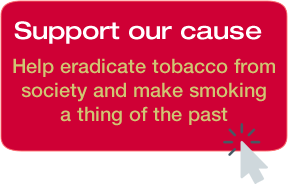Why
Why we specifically focus on smoking prevention among young people

Young people are the primary target group for the tobacco industry. The industry calls them the ‘replacement smokers’, who fill in for the smokers who died from their habit. Almost all smokers start smoking between the ages of 10 and 19. Young people who start smoking during this vulnerable period of their lives often become much more severely addicted than those who start later. That is why it is so important to protect young people from the temptations of the tobacco industry.
- Erasmus University research shows that the brains of adolescents and teenagers are much more vulnerable to becoming addicted than the adult brain. This is partly due to the fact that the cognitive functions of adolescents and teenagers are temporarily considerably reduced. Based on this research, one could say that adolescents are 'incapable' of making the choice whether or not to start smoking.
- Smoking appears to be 'contagious'. To see someone smoking, makes you want to smoke too.
- The World Health Organisation (WHO) therefore calls smoking in close proximity to children child abuse.
- Smoking starts in childhood, in the family and at school. It starts with mothers who continue to smoke during pregnancy because they are addicted. This leads to all kinds of misery for their children. From dismature (too small) babies, to fertility problems and possibly ADHD. Middle ear infections in children can often be directly traced back to smoking parents. There is also a clear link between smoking and cot death.
- Children of parents who are addicted to smoking have an increased risk of becoming addicted themselves. Today's addicted children will be the seriously ill smokers of twenty-five to thirty years from now. If we really want to do something about reducing the incidence of serious diseases - and possibly the costs they entail - we must make a serious start with young people now.
- Partly because there is such a long time between the first cigarette and the moment a smoker actually falls ill, the danger is not sufficiently recognised. Adolescents live in the here and now, parents still see their children's smoking as a harmless experiment. Until the age of 35, you can smoke, in a sense, 'with impunity'.
- In order to reach the – by nature adventurous – target group of adolescents, very targeted campaigns are needed that fit their way of thinking.





 Rookpreventie Jeugd is registered as a Public Benefit Organisation.
Rookpreventie Jeugd is registered as a Public Benefit Organisation.